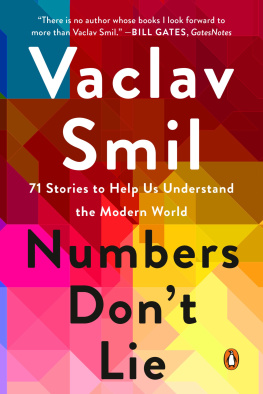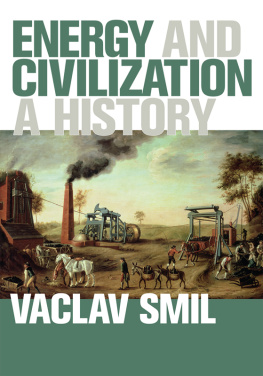Smil - Energy: a beginners guide
Here you can read online Smil - Energy: a beginners guide full text of the book (entire story) in english for free. Download pdf and epub, get meaning, cover and reviews about this ebook. City: London, year: 2017, publisher: Oneworld Publications, genre: Children. Description of the work, (preface) as well as reviews are available. Best literature library LitArk.com created for fans of good reading and offers a wide selection of genres:
Romance novel
Science fiction
Adventure
Detective
Science
History
Home and family
Prose
Art
Politics
Computer
Non-fiction
Religion
Business
Children
Humor
Choose a favorite category and find really read worthwhile books. Enjoy immersion in the world of imagination, feel the emotions of the characters or learn something new for yourself, make an fascinating discovery.
Energy: a beginners guide: summary, description and annotation
We offer to read an annotation, description, summary or preface (depends on what the author of the book "Energy: a beginners guide" wrote himself). If you haven't found the necessary information about the book — write in the comments, we will try to find it.
Smil: author's other books
Who wrote Energy: a beginners guide? Find out the surname, the name of the author of the book and a list of all author's works by series.
Energy: a beginners guide — read online for free the complete book (whole text) full work
Below is the text of the book, divided by pages. System saving the place of the last page read, allows you to conveniently read the book "Energy: a beginners guide" online for free, without having to search again every time where you left off. Put a bookmark, and you can go to the page where you finished reading at any time.
Font size:
Interval:
Bookmark:




Energy will do anything that can be done in the world.
Johann Wolfgang von Goethe (17491832)
All figures copyright Vaclav Smil, except where indicated.
Energy in our minds: concepts and measures
The word energy is, as are so many abstract terms (from hypothesis to sophrosyne), a Greek compound. Aristotle (384322 B.C.E.) created the term in his Metaphysics , by joining en (in) and (work) to form ( energeia , actuality, identified with movement) that he connected with entelechia , complete reality. According to Aristotle, every objects existence is maintained by energeia related to the objects function. The verb energein thus came to signify motion, action, work, and change. No noteworthy intellectual breakthroughs refined these definitions for nearly two subsequent millennia, as even many founders of modern science had very faulty concepts of energy. Eventually, the term became practically indistinguishable from power and force. In 1748, David Hume (17111776) complained, in An Enquiry Concerning Human Understanding , that There are no ideas, which occur in metaphysics, more obscure and uncertain, than those of power, force, energy or necessary connexion , of which it is every moment necessary for us to treat in all our disquisitions.
In 1807, in a lecture at the Royal Institution, Thomas Young (17731829) defined energy as the product of the mass of a body and the square of its velocity, thus offering an inaccurate formula (the mass should be halved) and restricting the term only to kinetic (mechanical) energy. Three decades later the seventh edition of the Encyclopedia Britannica (completed in 1842) offered only a very brief and unscientific entry, describing energy as the power, virtue, or efficacy of a thing. It is also used figuratively, to denote emphasis in speech. Little has changed in popular discourse since that, or indeed since Humes, time, except the frequency of the terms misuse. At the beginning of the twenty-first century energy, its derivative verb (energize) and its adjective (energetic), are used ubiquitously and loosely as qualifiers for any number of animated, zestful, vigorous actions and experiences, and energy is still routinely confused with power and force. Examples abound: a powerful new chairman brings fresh energy to an old company; a crowd is energized by a forceful speaker; pop-culture is Americas soft power.
Devotees of physical fitness go one step further and claim (against all logic and scientific evidence) they are energized after a particularly demanding bout of protracted exercise. What they really want to say is that they feel better afterwards, and we have a perfectly understandable explanation for that: prolonged exercise promotes the release of endorphins (neurotransmitters that reduce the perception of pain and induce euphoria) in the brain and hence may produce a feeling of enhanced well-being. A long run may leave you tired, even exhausted, elated, even euphoric but never energized, that is with a higher level of stored energy than before you began.
Science of energy: origins and abstracts
Sloppy use of ingrained terms is here to stay, but in informed writing there has been no excuse for ill-defined terms for more than a hundred years. Theoretical energy studies reached a satisfactory (though not perfect) coherence and clarity before the end of the nineteenth century when, after generations of hesitant progress, the great outburst of Western intellectual and inventive activity laid down the firm foundations of modern science and soon afterwards developed many of its more sophisticated concepts. The ground work for these advances began in the seventeenth century, and advanced considerably during the course of the eighteenth, when it was aided by the adoption both of Isaac Newtons (16421727) comprehensive view of physics and by engineering experiments, particularly those associated with James Watts (17361819) improvements of steam engines ().
During the early part of the nineteenth century a key contribution to the multifaceted origins of modern understanding of energy were the theoretical deductions of a young French engineer, Sadi Carnot (17961832), who set down the universal principles applicable to producing kinetic energy from heat and defined the maximum efficiency of an ideal (reversible) heat engine. Shortly afterwards, Justus von Liebig (18031873), one of the founders of modern chemistry and science-based agriculture, offered a basically correct interpretation of human and animal metabolism, by ascribing the generation of carbon dioxide and water to the oxidation of foods or feeds.

James Watt
The formulation of one of the most fundamental laws of modern physics originates in a voyage to Java made in 1840 by a young German physician, Julius Robert Mayer (18141878), as ships doctor. The blood of patients he bled there (the practice of bleeding as a cure for many ailments persisted well into the nineteenth century) appeared much brighter than the blood of patients in Germany.
Mayer had an explanation ready: blood in the tropics does not have to be as oxidized as blood in temperate regions, because less energy is needed for body metabolism in warm places. But this answer led him to another key question. If less heat is lost in the tropics due to radiation how about the heat lost as a result of physical work (that is, expenditure of mechanical energy) which clearly warms its surroundings, whether done in Europe or tropical Asia? Unless we put forward some mysterious origin, that heat, too, must come from the oxidation of blood and hence heat and work must be equivalent and convertible at a fixed rate. And so began the formulation of the law of the conservation of energy. In 1842 Mayer published the first quantitative estimate of the equivalence, and three years later extended the idea of energy conservation to all natural phenomena, including electricity, light, and magnetism and gave details of his calculation based on an experiment with gas flow between two insulated cylinders.
The correct value for the equivalence of heat and mechanical energy was found by the English physicist (see ) James Prescott Joule (18181889), after he conducted a large number of careful experiments. Joule used very sensitive thermometers to measure the temperature of water being churned by an assembly of revolving vanes driven by descending weights: this arrangement made it possible to measure fairly accurately the mechanical energy invested in the churning process. In 1847 Joules painstaking experiments yielded a result that turned out to be within less than one percent of the actual value. The law of conservation of energy that energy can be neither created nor destroyed is now commonly known as the first law of thermodynamics.
In 1850 the German theoretical physicist Rudolf Clausius (18221888) published his first paper on the mechanical theory of heat, in which he proved that the maximum performance obtainable from an engine using the Carnot cycle depends solely on the temperatures of the heat reservoirs, not on the nature of the working substance, and that there can never be a positive heat flow from a colder to a hotter body. Clausius continued to refine this fundamental idea and in his 1865 paper he coined the term entropy from the Greek (way) to measure the degree of disorder in a closed system. Clausius also crisply formulated the second law of thermodynamics: entropy of the universe tends to maximum. In practical terms this means that in a closed system (one without any external supply of energy) the availability of useful energy can only decline. A lump of coal is a high-quality, highly ordered (low entropy) form of energy; its combustion will produce heat, a dispersed, low-quality, disordered (high entropy) form of energy. The sequence is irreversible: diffused heat (and emitted combustion gases) cannot be ever reconstituted as a lump of coal. Heat thus occupies a unique position in the hierarchy of energies: all other forms of energy can be completely converted to it, but its conversion into other forms can never be complete, as only a portion of the initial input ends up in the new form.
Font size:
Interval:
Bookmark:
Similar books «Energy: a beginners guide»
Look at similar books to Energy: a beginners guide. We have selected literature similar in name and meaning in the hope of providing readers with more options to find new, interesting, not yet read works.
Discussion, reviews of the book Energy: a beginners guide and just readers' own opinions. Leave your comments, write what you think about the work, its meaning or the main characters. Specify what exactly you liked and what you didn't like, and why you think so.

















